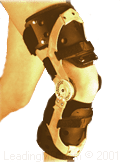ACL Injuries - Recovery
Non-operative Treatment
A good physical therapy program will focus on rehabilitation of the knee in two areas:
-
Strength - The muscles surrounding the knee, particularly the hamstring muscles, must be strengthened. These muscles can then take on some of the ACL's job of stabilizing the knee joint.
-
Proprioception - Proprioceptive nerves in the ligament send important information to the brain about where the body is in space. The brain then sends information to the muscles to tell them how to move the joint. The damaged nerves in the ligament must be retrained so that the muscles will move the joint properly.
A functional ACL brace will usually be prescribed to stabilize the knee and to prevent reinjury. Most functional braces incorporate a rigid frame. A trained specialist will fit the patient with the brace since a good fit is essential. Modern functional braces are lighter and much less bulky than older models. Patients find them easy to apply and comfortable to wear.
Operative Treatment
Following surgery, the patient will be started on a structured rehabilitation program. Patient commitment and involvement are essential for a good functional result. The specific exercises and program timelines vary depending on the graft source used, and whether surgical repair to other injured structures was performed.
The first phase of rehabilitation emphasizes range of motion, which is critical to avoid knee stiffness.
- A continuous passive motion (CPM) machine is used in the recovery room and the first night. This machine gently and steadily bends and straightens the patient's knee.
- Crutches are used for the first 7 -10 days after surgery for comfort. Full weight bearing would be painful.
- Riding a stationary bike without resistance and pool exercises to increase motion usually begin about 2 weeks after the surgery.
- Driving is allowed when the patient is comfortable and has mobility, often as early as 2 weeks after the operation.
- The patient returns for an office visit about 2 weeks after the surgery so the incision and range of motion can be checked.
The second phase of rehabilitation incorporates strengthening and usually begins about 6 weeks after surgery.
- A sports cord (an elastic resistance strengthening tool) and the treadmill are initially used.
- Use of a stair-stepper or elliptical trainer is added at about 8 weeks.
- Strengthening using weights is allowed at 2 - 3 months.
- The third phase of rehabilitation adds sport-specific exercises.
- Running is allowed at 3 months.
- Pivoting and twisting activities can begin at 4 to 5 months.
- This phase is usually customized for the patient's sports and activity level.
The final phase of rehabilitation involves a supervised return to sports. This usually occurs approximately 6 months after reconstructive surgery.

Are knee braces used after ACL reconstruction?
Bracing after an ACL reconstruction depends on the surgeon's preference. Some surgeons use no bracing while some use braces only during the rehabilitation phase. Still others recommend that patients always use a brace.
A post-operative brace is often used immediately after surgery. This is a large, sturdy brace that limits motion and helps protect the repair from an unexpected fall or twist. This type of brace is easily adjusted to accommodate the changes in the knee as swelling subsides.
A functional brace is lighter and less bulky and is often used during later stages of rehabilitation to protect the ACL reconstruction. Some surgeons recommend continued use of a custom-fit functional brace as a "safety-belt" during sports after this type of surgery.
What type of follow-up is done after an ACL reconstruction?
Usually, about a year following surgery, the doctor will evaluate the knee to measure the final results of the reconstruction in these areas:
- Motion
- Stability
- Symptoms such as pain or swelling
- How well the knee functions in daily living
- Whether or not the patient has been able to return to sports
- Some of these follow-up exams have shown that 90 to 95% of patients with ACL reconstructions have good to excellent results.
What types of complications can occur with an ACL reconstruction?
Stiffness in the joint, or lack of extension, is the most common complaint. This is why it is important to wait for motion to return and swelling to go down before surgery, and to follow the rehabilitation instructions given by the doctor and therapist.
Failure of the graft, reinjury to the ACL, or injury to other structures in the knee are possible, and can cause recurrent instability. Blood clots and infection in the joint are very rare occurrences.
BackNext